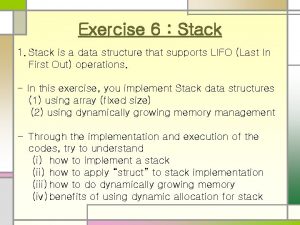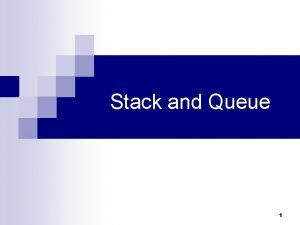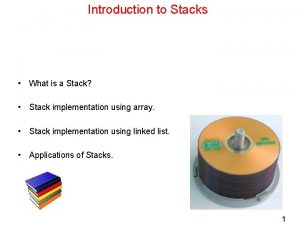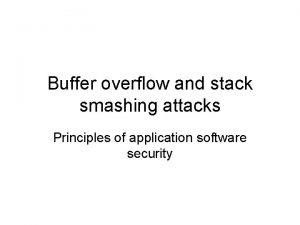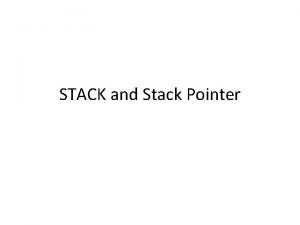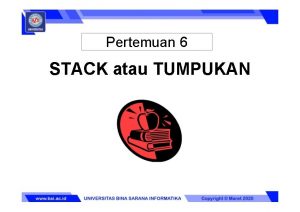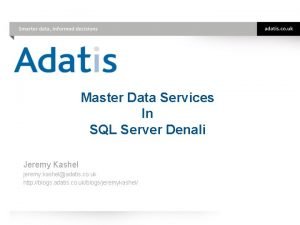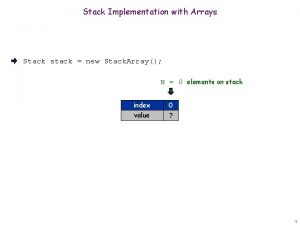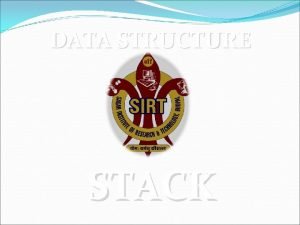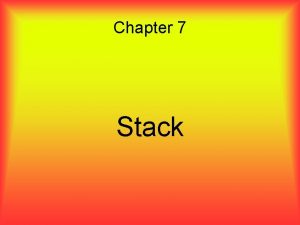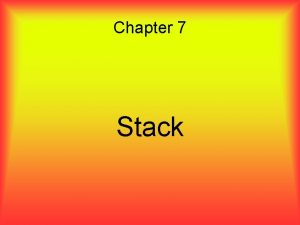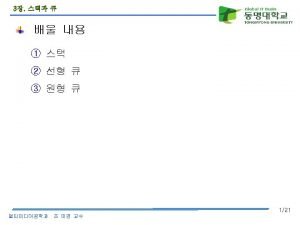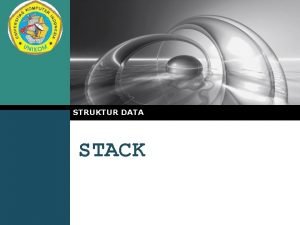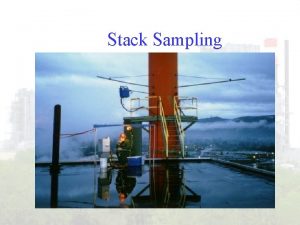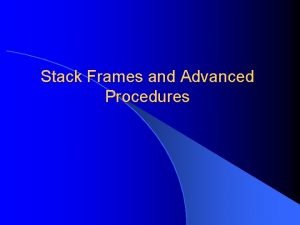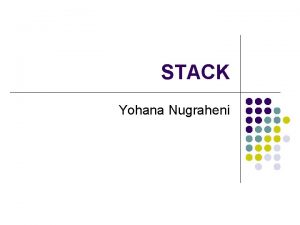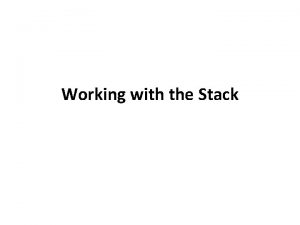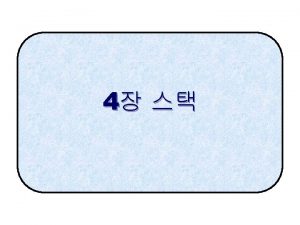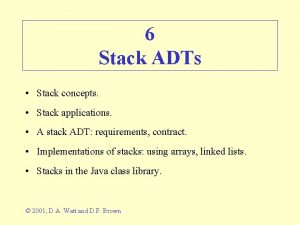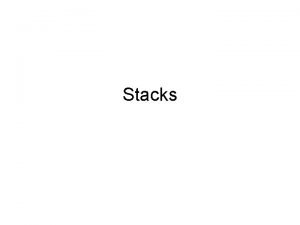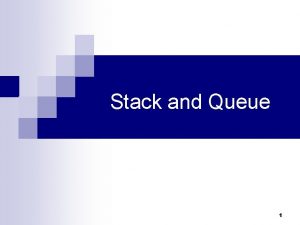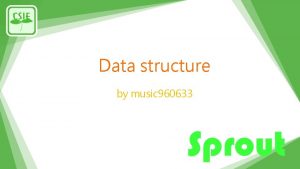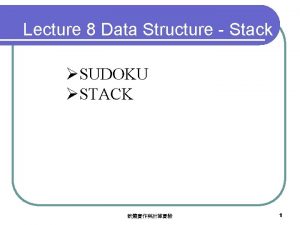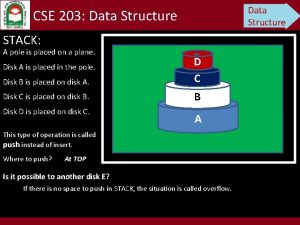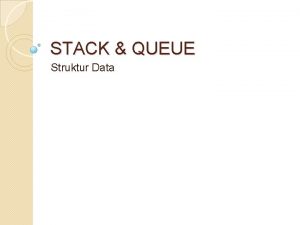Chapter 7 Stack Overview The stack data structure





































- Slides: 37

Chapter 7 Stack

Overview ● The stack data structure uses an underlying linear storage organization. The stack is one of the most ubiquitous data structures in computing.

Learning Objectives ● ● Describe the behavior of a stack. Enumerate the primary operations supported by the stack. Examine several applications of the stack, including parentheses matching, evaluating postfix expressions, and the conversion of an infix expression to postfix form. Understand the public interface of a stack class in Java and the running times of its methods.

Learning Objectives ● ● Develop a postfix package in Java to implement postfix expression evaluation. Study the implementation of a stack class in Java, and the trade-offs involved in choosing between candidate reusable components.

7. 1 Stack Properties ● ● Surfing the Web on a browser: The sequence of back clicks loads the browser with Web pages in reverse order of visit. The last visited page is the first loaded when going back. A stack is a collection of entries that demonstrates exactly this last in, first out behavior, called LIFO in short.

7. 1 Stack Properties

7. 1 Stack Properties ● ● An entry added or pushes on to the top of a stack. An entry is removed, or popped from the top of stack.

7. 1 Stack Properties

Results of Stack Operations Using Stack. Node (Cont’d) Internal View Abstract View

Results of Stack Operations Using Stack. Node (Cont’d) Internal View Abstract View

Results of Stack Operations Using Stack. Node (Cont’d) Internal View Abstract View

Results of Stack Operations Using Stack. Node (Cont’d) Internal View Abstract View

Results of push Operation

Results of push Operation (Cont’d)

Results of push Operation (Cont’d)

Results of push Operation (Cont’d)

Results of pop Operation top = top. next

7. 2. 2 Postfix Expression Evaluation ● We write arithmetic expressions like so: ● Consider the expression: ● It cannot simply be scan left to right.

7. 2. 2 Postfix Expression Evaluation ● ● Postfix, does away with the need for parentheses. An operator always follows the operands or sub-expressions on which it operates.

7. 2. 2 Postfix Expression Evaluation

7. 2. 2 Postfix Expression Evaluation

7. 2. 2 Postfix Expression Evaluation ● Two conditions that must be met for the evaluation process to terminate successfully: When an operator is encountered, there must exist a most recent pair of operands or temporary results for application. When the scanning of the expression is complete, there must be exactly one value on the stack.

7. 2. 2 Postfix Expression Evaluation

7. 2. 2 Postfix Expression Evaluation ● Two possible errors that may be encountered by the algorithm: One is that of insufficient operands. The other is that of too many operands. ● ● Insufficient operands case is detected when the token is an operator, but the stack has less than the two operands on which the operator must be applied. Too many operands case is detected after the while loop, when the stack has more than one entry in it.

7. 3 A Stack Class

7. 4 A Postfix Expression Evaluation Package ● Every step of the evaluation processes one token of the expression.

7. 4. 1 Class Postfix. Evaluator

7. 4. 1 Class Postfix. Evaluator java. util. String. Tokenizer parses the postfix expression into tokens and deals them out one at a time. Stack. Keeper maintains the evaluation stack.

7. 4. 1 Class Postfix. Evaluator

7. 4. 1 Class Postfix. Evaluator ● ● Run. All message evaluates and produces the results in one shot. Restart the evaluator by the init message.

7. 4. 3 Class Stack. Keeper

7. 4. 3 Class Stack. Keeper

7. 4. 3 Class Stack. Keeper

7. 4. 3 Class Stack. Keeper

7. 4. 4 Class Postfix. Evaluator Implementation

7. 4. 4 Class Postfix. Evaluator Implementation ● The String. Tokenizer method count Tokens returns the number of tokens that remain to be enumerated. At the end of the run, the stack must contain exactly one element.

7. 4. 4 Class Postfix. Evaluator Implementation ● The No. Such. Element. Exception does two things: Prints the current evaluation status so the calling application gets as much information as possible about the source of the exception. Throws an Illegal. Expression. Exception, in order to deliver the most precise and complete information about the cause of the exception. ● This is much better than just passing through the No. Such. Element. Exception, which, in this context, is not informative enough.
 Data quality and data cleaning an overview
Data quality and data cleaning an overview Data quality and data cleaning an overview
Data quality and data cleaning an overview Data quality and data cleaning an overview
Data quality and data cleaning an overview Static data structure
Static data structure Stack data structure exercises
Stack data structure exercises First in first out
First in first out Postfix expression
Postfix expression Stack smashing vs buffer overflow
Stack smashing vs buffer overflow Stack pointer definition
Stack pointer definition Perintah isempty create stack hasilnya adalah
Perintah isempty create stack hasilnya adalah Master data services overview
Master data services overview Mds sql server
Mds sql server Chicago time
Chicago time An overview of data warehousing and olap technology
An overview of data warehousing and olap technology Trajectory data mining an overview
Trajectory data mining an overview Methodologies for cross-domain data fusion: an overview
Methodologies for cross-domain data fusion: an overview Hát kết hợp bộ gõ cơ thể
Hát kết hợp bộ gõ cơ thể Ng-html
Ng-html Bổ thể
Bổ thể Tỉ lệ cơ thể trẻ em
Tỉ lệ cơ thể trẻ em Chó sói
Chó sói Tư thế worm breton
Tư thế worm breton Chúa yêu trần thế alleluia
Chúa yêu trần thế alleluia Các môn thể thao bắt đầu bằng tiếng chạy
Các môn thể thao bắt đầu bằng tiếng chạy Thế nào là hệ số cao nhất
Thế nào là hệ số cao nhất Các châu lục và đại dương trên thế giới
Các châu lục và đại dương trên thế giới Công thức tiính động năng
Công thức tiính động năng Trời xanh đây là của chúng ta thể thơ
Trời xanh đây là của chúng ta thể thơ Cách giải mật thư tọa độ
Cách giải mật thư tọa độ Làm thế nào để 102-1=99
Làm thế nào để 102-1=99 độ dài liên kết
độ dài liên kết Các châu lục và đại dương trên thế giới
Các châu lục và đại dương trên thế giới Thể thơ truyền thống
Thể thơ truyền thống Quá trình desamine hóa có thể tạo ra
Quá trình desamine hóa có thể tạo ra Một số thể thơ truyền thống
Một số thể thơ truyền thống Cái miệng nó xinh thế chỉ nói điều hay thôi
Cái miệng nó xinh thế chỉ nói điều hay thôi Vẽ hình chiếu vuông góc của vật thể sau
Vẽ hình chiếu vuông góc của vật thể sau Nguyên nhân của sự mỏi cơ sinh 8
Nguyên nhân của sự mỏi cơ sinh 8




